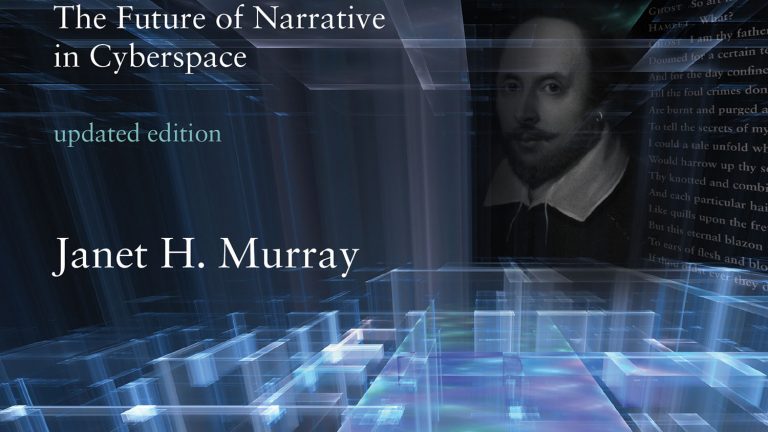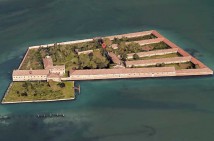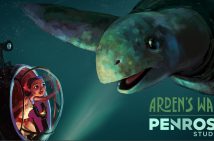Submarine Channel

The Holodeck Reloaded – Janet Murray talks VR, AR and why she’s so good at predicting things
The Holodeck Reloaded – Janet Murray talks VR, AR and why she’s so good at predicting things
By Davide Banis
When I meet Janet Murray she had just finished her keynote speech at the Nederlands Film Festival in Utrecht, the most important Dutch film festival. She lectured about the themes that made her an academic heavyweight worldwide: interaction design, the future of storytelling and the new narrative affordances granted by digital media.
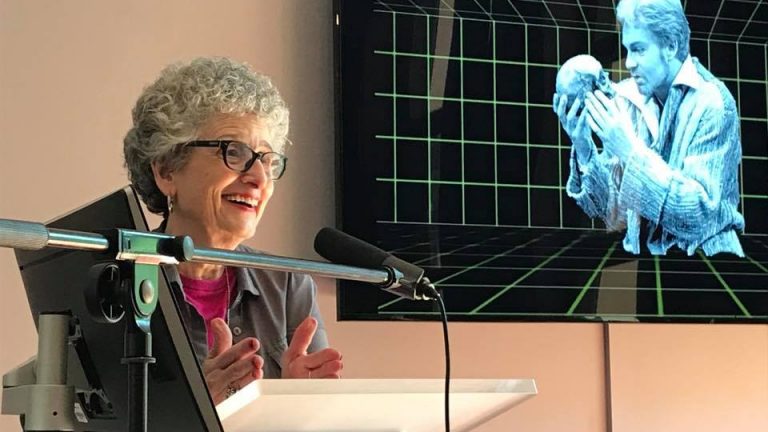
Here, Janet Murray lecturing at the University of Utrecht last May (picture by Harmut Koenitz)
Last April, her widely influential 1997 media bible Hamlet on the Holodeck- The Future of Narrative in Cyberspace was reissued in an updated edition. When asked about a new preface and update for the book, Murray was tempted to make it three words long: “I was right!” Despite her sharp scholarly self-confidence, Janet Murray doesn’t dispense knowledge from an unreachable academic pulpit. To the contrary, she comes across as a curious person, eager to learn new things (after my interview, she spent the rest of the day listening in the front row to all the other festival’s talks) and always ready to engage in some form of intellectual wrestling. Her remarks are trenchant not because they’re unquestionable but rather because she challenges you to question them, provided you have enough intellectual oxygen and practical attitude to plunge yourself into the deep water of immersive storytelling.
Thanks God we have a Submarine…
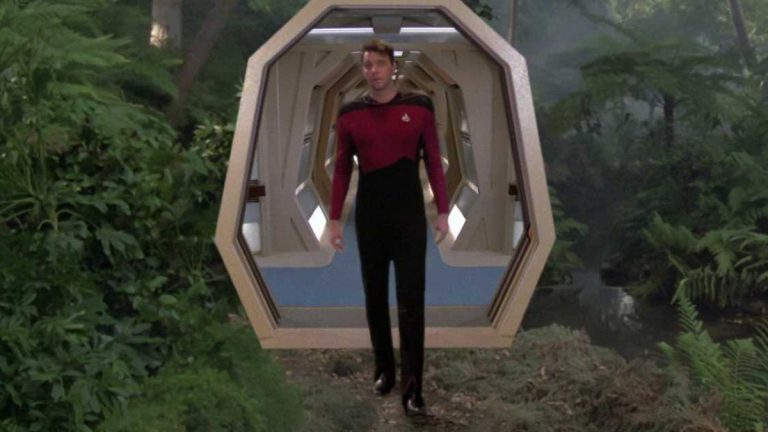
The idea of the Holodeck as a virtual reality environment comes from the TV series Star Trek
Why should young students that are maybe old as this book still read Hamlet on the Holodeck?
It’s indeed unusual for books about the future of technology to remain relevant for so long. Hamlet on the Holodeck is an exception because it was able to outline a set of possibilities in the field of interactive storytelling that are still relevant nowadays. For example, I described the four properties of the digital that then became the basis of my courses in interactive design; in particular, any digital artifact is potentially procedural (that means made of executable procedures), participatory (it invites human interaction), encyclopedic (it can store high capacity of multimedia information) and spatial, meaning that is possible to navigate through it as a virtual space..Starting from this point of view of a new medium with its own affordances allowed me to address the long-term potentials for storytelling that were exploited over the past two decades, but are still very open for exploration and innovation.
And how was it that you were able to predict all these things?
Well, I had two big advantages. The first one is that at the time I was working at the MIT where there was a high level of technological, future-looking expertise; basically, it was the place where a lot of the issues that hit the wider society later – like the migration of print and video to networked digital delivery platforms — were anticipated. While the second one lies in my training as a literary scholar that gave me the ability to look at the long-term directions of change : the way genres develop over centuries, not years- and to think about the deeper expressive purposes of storytelling.
VR has been oversold. We’re still at the equivalent
stage of the invention of the movie camera.
I’d like to propose to you three pairs of concepts and to ask you to help me elaborate a discussion around them.
Sure, go ahead.
The first pair is interactive-immersive. They’re usually presented as two sides of the same coin but it seems to me that we increasingly have entertainment that is incredibly immersive without being interactive at all. I’m thinking, for example, at the world-building of TV series like Game of Thrones.
Well, I have a quite strong position on that; I do recognize that we want to surrender to a world that is given to us but I also think that once something is in a digital form we become impatient to act in it, maybe just navigating it to see it differently. I strongly believe that interactivity and immersion reinforce one another and I call this phenomenon the “active creation of belief”; the more detailed and consistent a world is, the more it arouses our curiosity and desire, the more we want to test it and see where its boundaries are. And when it responds in a coherent way that deepens our immersion…I mean you can have this experience of immersion reinforced by interactivity even just following the hypertexted knowledge trails in Wikipedia…
I know that all too well. I always say that it’s almost an Olympic sport: jumping from article to article on Wikipedia at 3 am in the morning.
Hahah that’s so true!
Anyway, the second pair I wanted to ask your opinion about consists of the terms Virtual and Augmented Reality. Two of the most trending media fads at the moment.
I think that Augmented Reality has a lot of potential but mainly for characters that are the size of Pokemons that come into the world through your phone. Indeed, things go wrong when you design your AR experience beyond the affordances of the platform. For example, when there’s a hologram sitting in front of you across the table but you can see only the head and you have to move the phone to see all the other parts. That can be really bad. As for Virtual Reality…well, Virtual Reality has been oversold. We’re still at the equivalent stage of the invention of the movie camera. We’re really like at the Lumiere’s 1895 film showing the arrival of a train at the Ciotat Station. In other words, we still have to invent the conventions to fully explore VR’s narrative capacities.
Our imagination is so forceful that it frightens us,
and when we have a new medium we become newly aware of how easily we can be deceived.
In this regard, can you already identify some VR pieces that are significant for the development of these conventions?
I very much admire Nonny de la Peña’s works. I often repeat her dictum “you start with the feeling of the body in the space” because that’s for me completely right. She also really understands that in VR you need 3D space that you can move through, not just look at. Another example that I really like is a game released for free in preview from WEVR called Gnomes and Goblins by Jon Favreau [Iron Man’s director, Ed] because it features all the narrative opportunities that I listed as missing in a lot of previous projects. It’s a real narrative game, you have clear interaction patterns and the game mechanics are transparent. And then aesthetically it looks like a mature imaginary world.
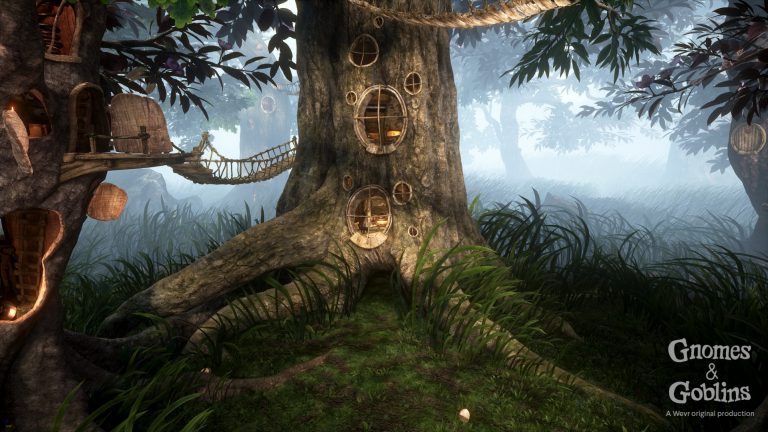
Image from WeVR’s Gnomes & Goblins
The third conceptual pair I want to draw your attention to is the divide fiction and reality. From post-factuality to immersive storytelling, it seems that it is increasingly difficult to tell them apart.
The blurring of the boundary between reality and fiction is a perennial human concern. Already Socrates [via Plato Ed.] was concerned by how poetry made us unable to distinguish between real and fake. The thing is that our imagination is so forceful that it frightens us, and when we have a new medium we become newly aware of how easily we can be deceived and we become afraid that it will fool us and that we will fall prey to hoaxes. We just have to develop the rituals and the conventions that allow us to recognize what’s reliable and what’s not. It’s a short term cultural problem; It’s fixable!
Full of optimism, I ask you one last question. May you give us one prediction about the future?
One of the things I predicted well was the growth of long-form television. In particular the fact that writers would be able to tell longer, more coherent stories thanks to digital transmission. I think that we will outgrow this kind of sequential episodic format because these multi-threaded stories with multiple-characters arcs have become so dense that you almost need a second screen aid to understand what’s going on, who all these people are…I mean there could be a hundred characters in a show like Game of Thrones. So I think that in the future there could be more ways of navigating through the story-world where you could follow one thread rather than all of them (for example, just Arya’s story-arc in Game of Thrones) and maybe then trade information with other people or something along these lines but you would sort of pick an allegiance, so to speak. I’m working on models for this with my students!
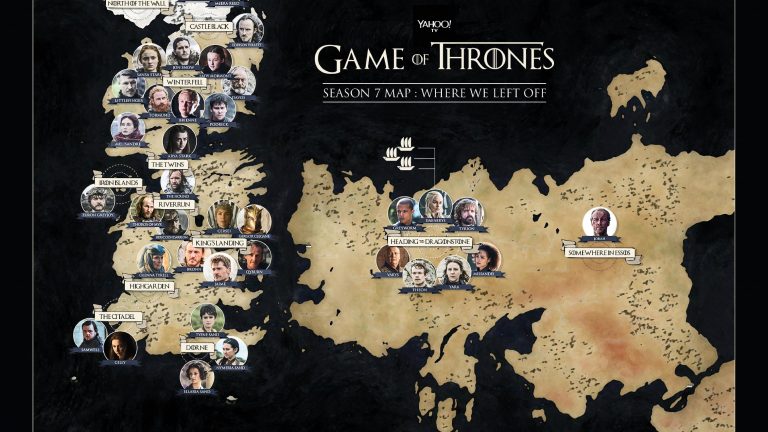
Maps are becoming increasingly important for storytelling (Designed by Quinn Lemmers for Yahoo)
Regretting to not be a Georgia Tech graduate student, I say goodbye to professor Murray. When I’m about to leave, for a moment she doesn’t find her phone, then realizing it’s in the pocket of her jacket. “I’m really the clichè of the absent-minded professor” she quips. But actually she’s not. In a difficult academic field such as the humanities that battles constantly to find an identity after the postmodern bender, Janet Murray is like an optimistic sprite that could come from the world of Gnomes and Goblins, a hands-on academic that urges us to integrate practice and theory and to look trustingly at the future because the game is far from over.
Davide Banis
Davide is a 24 yo Italian guy. He studied Media Studies in Amsterdam and Philosophy in Milan. When he grows up he wants to become a superhero.
